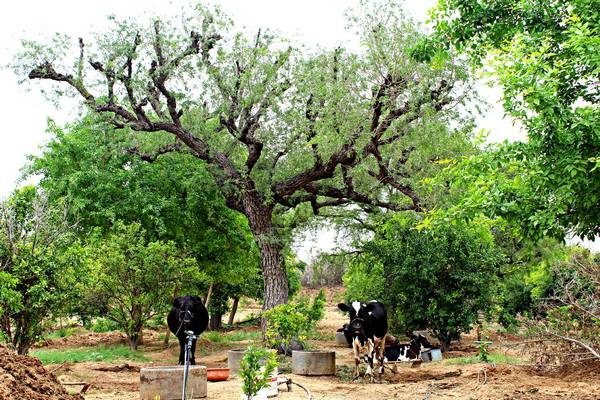By Sneh Yadav
(Photo © Benefit Publishing Pvt Ltd)
Biodynamic farming takes into account the soil, animals, humans, and plants of a farm as one cohesive unit. And it is NOT the same as Organic Farming
People that are interested in organic farming or buying organic products often confuse organic farming with biodynamic farming. Although with many similarities, the two farming styles are not the same.
While organic farming has been around since the pre-Green Revolution era in India, biodynamic farming, which, although popular in Europe—where it was first introduced in 1925—is only now slowly being actively introduced in the farming community in India.
Biodynamics
Biodynamics, a term coined by the Austrian philosopher Rudolf Steiner, means holistic and spiritual approach to agriculture. The story goes that in 1924, few farmers who were worried about their poor produce approached Steiner for suggestions. In response, Steiner delivered few lectures based on traditional European farming wisdom with new inputs from anthroposophy. This new approach came to be known as Biodynamics.
Biodynamic farming is a well thought out and tested approach and is applicable to the overall structure of farms. Its core philosophy stresses on the creation of a farm that functions holistically as one entity, with its soil, animals, humans, and plants projected as diverse ‘organs of one living organism’
Biodynamics was conceived not only to increase and improve agricultural production but also to give healing power to produces by the process of healing the complete farm—the entire farm, the crops and the produces being considered one entity, that is.
By the 1950s this approach had become popular in Europe. It was around this time that that American author J I Rodale used the term ‘organic’ in his writings: ‘Organic Gardening’ appeared for the first time.
Biodynamic farming has many similarities with organic agriculture. Both emphasise on the importance of good soil health, prohibit the use of synthetic chemicals, and advocate the use of compost, green manure, and integrated pest and weed management. So now you’re probably wondering how organic and biodynamic farming differ from each other.
Organic Vs Biodynamic
For one, biodynamic farming uses—in addition to all the methods used in organic farming—few other substances such as fermented manure, and plant and mineral based preparations, which are added to the soil, crops, and compost. These substances are said to stimulate soil nutrient cycle, compost development, and photosynthesis.
Another differing and important component of biodynamic farming, introduced by Steiner, is the flow of cosmic energy in all components of farming. Biodynamic farming is also a well thought out and tested approach and is applicable to the overall structure of farms. Its core philosophy stresses on the creation of a farm that functions holistically as one entity, with its soil, animals, humans, and plants projected as diverse “organs of one living organism”. The health of the “farm as an organism” depends on each of its organs working in synergy with the other organs, as well as with its environment. Energies must flow between each organ in coordination with the cosmic energy of the universe, leading to the creation of a self sustained farm.
To take a step back and approach this more practically, a farm’s manure and compost requirements can be achieved from the farm waste, legumes, cover crops and animal waste. A well managed livestock is also an integral component of biodynamic farming. Control of weeds and pests is achieved through mechanical or physical removal, homeopathy, crop rotation, and other non chemical means.
Biodynamic agriculture is a subset of the more general organic agriculture. It uses different biodynamic preparations for the soil and plants, based on different compost, minerals, plants and herbs, with all farm activities being guided by the lunar calendar.
Positive Impact
Biodynamic preparations affect the soil microbial community directly through inoculation, and indirectly by changing the habitat and stimulating microbial growth. A change/increase in microbial community controls diseases in plants and increases the availability of nutrients in the soil. Typically, artificial addition of microbes will be short lived without a proper supporting environment for it. Availability of food and habitat for the beneficial microbes determines the size and make up of the microbial community. Repeated application combined with habitat enhancement methods leads to a lasting change in the soil microbial community.
This agronomic system is based on a holistic approach of the whole farm, and hence, only the use of preparations will not be defined as a biodynamic approach to farming. However, the only way to compare results from different farming systems is by studying the effects of different preparations on the plant and the soil. The use of biodynamic methods and preparations on thousands of farms suggests that there are real benefits. Ample positive changes were noticed in Tijara Organic Farm in Rajasthan after biodynamic preparations were used in the farm in a systematic way. Protection from frost and fungal infection, and improvement in soil fertility and taste of produces were the most major changes noticed.
Like many organic techniques, the effects and benefits of biodynamic farming are enjoyed most after a significant period of time. As much like how the saying ‘As you sow, so shall you reap’ goes, biodynamic harvest is most worthy of the time and effort that goes into its cultivation.
The author is a Biologist and Founding Member of the Delhi Organic Farmers’ Market, New Delhi. She also operates her biodynamic farm, Tijara, in Rajasthan
This article appeared in the October 2015 issue of Pure & Eco India



Hello
Can I get more details on biodynamic farming?